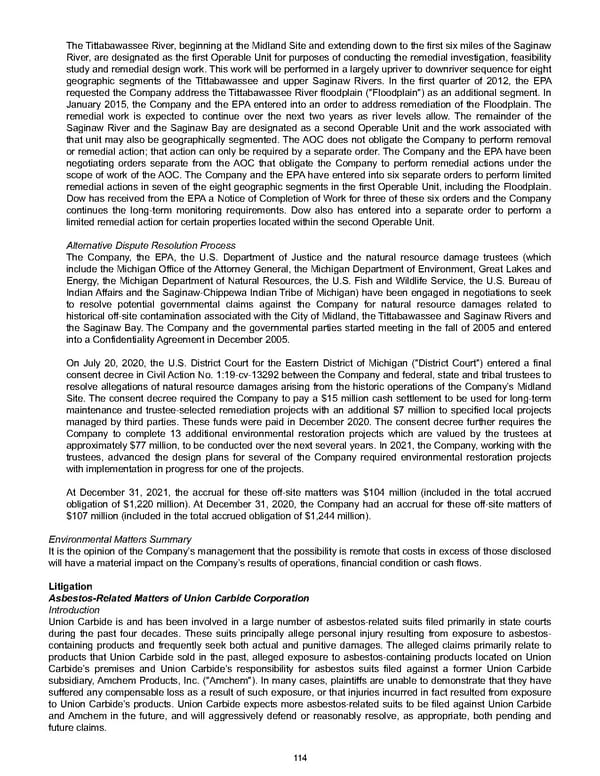The Tittabawassee River, beginning at the Midland Site and extending down to the first six miles of the Saginaw River, are designated as the first Operable Unit for purposes of conducting the remedial investigation, feasibility study and remedial design work. This work will be performed in a largely upriver to downriver sequence for eight geographic segments of the Tittabawassee and upper Saginaw Rivers. In the first quarter of 2012, the EPA requested the Company address the Tittabawassee River floodplain ("Floodplain") as an additional segment. In January 2015, the Company and the EPA entered into an order to address remediation of the Floodplain. The remedial work is expected to continue over the next two years as river levels allow. The remainder of the Saginaw River and the Saginaw Bay are designated as a second Operable Unit and the work associated with that unit may also be geographically segmented. The AOC does not obligate the Company to perform removal or remedial action; that action can only be required by a separate order. The Company and the EPA have been negotiating orders separate from the AOC that obligate the Company to perform remedial actions under the scope of work of the AOC. The Company and the EPA have entered into six separate orders to perform limited remedial actions in seven of the eight geographic segments in the first Operable Unit, including the Floodplain. Dow has received from the EPA a Notice of Completion of Work for three of these six orders and the Company continues the long-term monitoring requirements. Dow also has entered into a separate order to perform a limited remedial action for certain properties located within the second Operable Unit. Alternative Dispute Resolution Process The Company, the EPA, the U.S. Department of Justice and the natural resource damage trustees (which include the Michigan Office of the Attorney General, the Michigan Department of Environment, Great Lakes and Energy, the Michigan Department of Natural Resources, the U.S. Fish and Wildlife Service, the U.S. Bureau of Indian Affairs and the Saginaw-Chippewa Indian Tribe of Michigan) have been engaged in negotiations to seek to resolve potential governmental claims against the Company for natural resource damages related to historical off-site contamination associated with the City of Midland, the Tittabawassee and Saginaw Rivers and the Saginaw Bay. The Company and the governmental parties started meeting in the fall of 2005 and entered into a Confidentiality Agreement in December 2005. On July 20, 2020, the U.S. District Court for the Eastern District of Michigan ("District Court") entered a final consent decree in Civil Action No. 1:19-cv-13292 between the Company and federal, state and tribal trustees to resolve allegations of natural resource damages arising from the historic operations of the Company’s Midland Site. The consent decree required the Company to pay a $15 million cash settlement to be used for long-term maintenance and trustee-selected remediation projects with an additional $7 million to specified local projects managed by third parties. These funds were paid in December 2020. The consent decree further requires the Company to complete 13 additional environmental restoration projects which are valued by the trustees at approximately $77 million , to be conducted over the next several years. In 2021, the Company, working with the trustees, advanced the design plans for several of the Company required environmental restoration projects with implementation in progress for one of the projects. At December 31, 2021 , the accrual for these off-site matters was $104 million (included in the total accrued obligation of $1,220 million ). At December 31, 2020 , the Company had an accrual for these off-site matters of $107 million (included in the total accrued obligation of $1,244 million ). Environmental Matters Summary It is the opinion of the Company’s management that the possibility is remote that costs in excess of those disclosed will have a material impact on the Company’s results of operations, financial condition or cash flows. Litigation Asbestos-Related Matters of Union Carbide Corporation Introduction Union Carbide is and has been involved in a large number of asbestos-related suits filed primarily in state courts during the past four decades. These suits principally allege personal injury resulting from exposure to asbestos- containing products and frequently seek both actual and punitive damages. The alleged claims primarily relate to products that Union Carbide sold in the past, alleged exposure to asbestos-containing products located on Union Carbide’s premises and Union Carbide’s responsibility for asbestos suits filed against a former Union Carbide subsidiary, Amchem Products, Inc. ("Amchem"). In many cases, plaintiffs are unable to demonstrate that they have suffered any compensable loss as a result of such exposure, or that injuries incurred in fact resulted from exposure to Union Carbide’s products. Union Carbide expects more asbestos-related suits to be filed against Union Carbide and Amchem in the future, and will aggressively defend or reasonably resolve, as appropriate, both pending and future claims. 114
 Annual Report Page 123 Page 125
Annual Report Page 123 Page 125